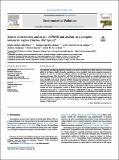Por favor, use este identificador para citar o enlazar a este item:
http://hdl.handle.net/10261/266040COMPARTIR / EXPORTAR:
 SHARE SHARE
 CORE
BASE CORE
BASE
|
|
| Visualizar otros formatos: MARC | Dublin Core | RDF | ORE | MODS | METS | DIDL | DATACITE | |

| Título: | Source contribution and origin of PM10 and arsenic in a complex industrial region (Huelva, SW Spain) |
Autor: | Millán-Martínez, María; Sánchez-Rodas, Daniel; Sánchez de la Campa, A M; Alastuey, Andrés CSIC ORCID; Querol, Xavier CSIC ORCID ; de la Rosa, Jesús D. CSIC ORCID | Palabras clave: | PM10 Arsenic speciation Complex industrial area Pollutant gases Sulfide material |
Fecha de publicación: | 1-abr-2021 | Editor: | Elsevier | Citación: | Environmental Pollution 274: 116268 (2021) | Resumen: | Air pollution coming from industrial activities is a matter of interest since their emissions can seriously affect to the human health of nearby populations. A more detailed study about industrial emissions is required in order to discriminate different activities contributing to pollutant sources. In this sense, gaseous pollutants (NO2, SO2 and O3) and PM10 levels has been studied in a complex industrial area in the southwest of Spain (La Rabida and the nearby city of Huelva) during the period 1996-2017. Hourly, daily, monthly and annual variations of PM10 and gaseous pollutants concentrations point to the industrial activity as the main SO2 source. Furthermore, traffic and resuspension emissions contribute to the NO2 and PM10 levels, respectively. Results from chemical composition of PM10 at both sites during the period 2015-2017 are characterized by high concentrations of the crustal components derived from natural and local resuspension. Arsenic is found to be the main geochemical anomaly at La Rabida (annual mean of 7 ng m-3), exceeding the European annual target of 6 ng m-3, which supposes a risk for the nearby population. An emission source from Cu-smelter has been identified in La Rabida and Huelva. A second source corresponding to emissions from polymetallic sulfides handling in a port area has been described for the first time in La Rabida. In addition, arsenic speciation results have identified three different As impacts scenarios as a function of the dominant wind direction, the SO2 episodes and the As extraction efficiency: impact of the Cu-smelter, impact of the bulk polymetallic sulfides and a mixed impact of both sources. | Versión del editor: | https://doi.org/10.1016/j.envpol.2020.116268 | URI: | http://hdl.handle.net/10261/266040 | DOI: | 10.1016/j.envpol.2020.116268 | ISSN: | 02697491 |
| Aparece en las colecciones: | (IDAEA) Artículos |
Ficheros en este ítem:
| Fichero | Descripción | Tamaño | Formato | |
|---|---|---|---|---|
| 1-s2.0-S0269749120369578-main.pdf | Artículo principal | 1,49 MB | Adobe PDF |  Visualizar/Abrir |
CORE Recommender
PubMed Central
Citations
2
checked on 10-abr-2024
SCOPUSTM
Citations
13
checked on 23-abr-2024
WEB OF SCIENCETM
Citations
12
checked on 23-feb-2024
Page view(s)
32
checked on 01-may-2024
Download(s)
114
checked on 01-may-2024
Google ScholarTM
Check
Altmetric
Altmetric
Artículos relacionados:
NOTA: Los ítems de Digital.CSIC están protegidos por copyright, con todos los derechos reservados, a menos que se indique lo contrario.
